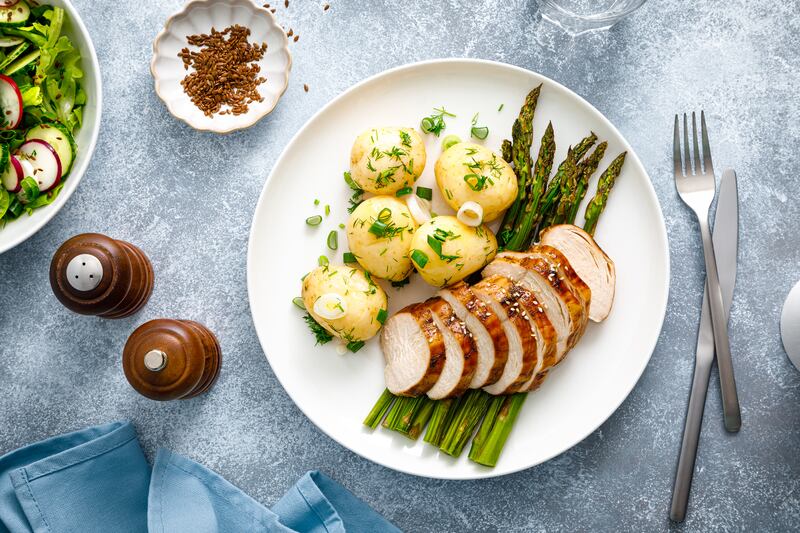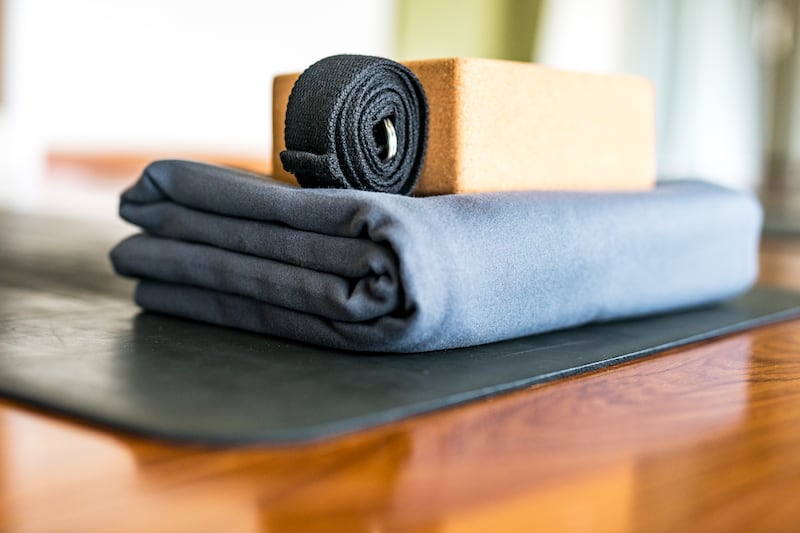An all-out fitness campaign often seems like a good idea at the start of the year. But lifestyle overhauls are usually destined to fail, simply because they’re unrealistic. By taking your time and finding exercise routines you actually enjoy, you’re more likely to develop healthy habits you can stick with. We asked fitness experts for the one tip they would give someone who wanted to get fit – or fitter – in 2023. This is what they told us.
Start with tiny changes
If you try to copy the fitness routine of an Olympic athlete, you’ll struggle to keep it up. Make small tweaks to your day instead, such as adding in a set of squats before you get in the shower, doubling up on dog walks or doing 10 jumping jacks every time you go to the bathroom. You can even use a kitchen worktop to do a few press-ups while you’re waiting for the kettle to boil. Jay Unwin Mental and physical fitness consultant
Live by the 80/20 rule
Try sticking to nutritious, whole foods 80% of the time and incorporate your favourite treats into the remaining 20 per cent of your diet. Francesca Lancaster, nutritionist
Take advantage of your environment
Whether it’s the beach, the forest or your local park, your surroundings provide plenty of natural training equipment. You can run up skate pipes, find logs to use as weights, use steps for elevated lunges or use a bike rack for triceps dips. Lori-Louise Boyton, personal trainer
Met Gala 2025 in pictures: Barry Keoghan and Andrew Scott fly Irish flag while Diana Ross leads with opulence
Adam Loughnane asked for help at a Galway hospital. Three hours later he was dead
Lottie Ryan on family life in an apartment: ‘It is very likely our forever home’
Thunderbolts* star Florence Pugh on getting her way: ‘I was very sassy. I cornered a few people’
Rub your palms together vigorously before getting out of bed
It might sound strange but doing this for a minute or two each morning increases energy levels, helping us to perform with more efficiency. It’s a good starting point for anyone who is feeling stiff or struggling with mobility. Miranda McCarthy, accessible yoga specialist
Take a free exercise class
You don’t have to spend a fortune to find a new hobby, and plenty of places (for example, Zumba classes) offer free trials. As a plus-sized dance fitness instructor, I understand it can be a struggle for some people to kick-start their plans. By remaining open-minded and trying lots of different classes, you’ll find something you enjoy and be more likely to stick to it. Kat Henry, dance teacher

Have dinner for breakfast
Many people don’t get enough protein in the morning, which affects their energy for exercising, as well as their food choices throughout the day. The more tired you feel, the more likely you are to reach for that chocolate bar for an instant hit. Try having roast chicken, potatoes and spinach for breakfast, or fresh salmon, eggs and green vegetables. It will set you up better for the day. Thalia Pellegrini, nutritional therapist
Reframe self-care as a necessity
Whether it’s committing to a yoga class, a walk or a short run, try to carve out that time for yourself every day. Treat it as non-negotiable, the same way you treat other forms of self-care such as showering, eating or brushing your teeth. Claire Mace, yoga teacher
Download apps to explore the outdoors
Gym classes aren’t for everyone, but a hiking trip means you can combine sightseeing with exercise. Apps such as OS Maps, Strava, AllTrails and Komoot are great for picking new and interesting routes, whether you’re experienced or a beginner. You could also join a local walking group if you’d rather get fit in a social setting. Chris Bone, the founder of the non-profit company Green Pathway Outdoors
Build muscle first
Most people turn to cardio when they start their fitness regime, but it’s more important to build muscle through lifting and body weight exercises, especially for women who are going through the menopause. You don’t need expensive weights – tin cans and water bottles will do the job. Sam Palmer, nurse and menopause fitness specialist
Remember 10 is the magic number
When it comes to fitness, the 10th class or workout is usually a breakthrough moment. If you feel like giving up early on, keep going, because there will be a moment when it just clicks and you start feeling the mental and physical benefits. Rowan Feilden-Cook, trainer and mindset coach
Add 15 minutes to your existing routines
If you struggle to find the time to exercise, small tweaks to your day can make a big difference. For example, if you usually walk to school with your children in the morning, take the longer route home. Mari-Carmen Sanchez-Morris, women’s health and fitness coach

Use yoga props
If you’re trying yoga for the first time, invest in blocks, straps and other support tools, or find a studio that offers them. Props will help you get into the poses and reduce the risk of injury when you’re getting started. They can also help make yoga more adaptive for people with disabilities and mobility challenges. Basma Gale, yoga teacher
Eat intuitively
It’s common to start a “deprivation” diet to kick-start your fitness regime, but it’s usually unsustainable. Instead, eat what you want, but only when you’re physically hungry. Eat slowly and pay attention to the textures, flavours and aromas, as well as the fullness signals from your body. Slowing down and being mindful can help to prevent overeating. Annabella Zeiddar, therapist and coach
Up the intensity
To grow stronger, your body needs to be pushed beyond its comfort levels. For example, if you’re going for a 15-minute run every day, try to gradually increase the distance you’re running in that time, rather than the length of time you spend running. You’ll need to build your stamina bit by bit and be mindful of your body’s limitations to avoid injury. Duncan Attwood, personal trainer
Use a heart monitor while cycling
There is plenty of technology that can help you tailor your workout to your body’s needs. If you’re new to cycling or building your strength, I recommend alternating your energy levels, going hard for one minute then easy for two, and repeating for the duration of your workout. Kelsey Mitchell, Olympic cycling champion
Meditate
It’s good for relaxation, but meditating after exercise will also help to lower your cortisol levels and ease you back into balance. It can boost those feelgood endorphins when you’ve completed a workout. Chloë Webster, meditation teacher
Be accountable
If you write your goals in your diary you’re more likely to stick to them. You can also try arranging to meet a friend for an exercise session. By making it a part of your schedule – especially if others are involved – you’ll find it easier to carve out the time. Tori Sharp, personal trainer
Practise breathing techniques
Functional breathing exercises, which you can learn online, can boost your health and fitness by supporting faster recovery and enabling you to train more comfortably for longer periods. Matt Bagwell, Paralympic and Olympic instructor
Set ‘Smart’ goals
When you’re starting your fitness journey, it’s important to know exactly what you want to achieve before deciding how you’re going to get there. Once you know that, it’s time to implement the Smart theory by setting goals that are specific, measurable, attainable and relevant, as well as being time-sensitive to your own needs. Kirsten Whitehouse, women’s fitness and mindset coach
Gamify routines
If you find it hard to get going with basic exercises, try gamifying the process. Strava segments, streaks, virtual badges, online medals and personal bests are popular ways to boost your motivation. Michelle Flynn, health coach
Try hypopressive training
These are brilliant low-impact, breath-led exercises for women to help strengthen the pelvic floor. They take just 10 minutes a day and can help you to build the confidence you need to train – without worrying about embarrassing accidents. Kirsty Victoria, postnatal health practitioner
Ditch the all-or-nothing attitude
From eating well to exercising, staying healthy can seem overwhelming. It’s not realistic to become a health guru overnight, but adopting some healthy habits (such as walking or eating an extra piece of fruit) all the time is better than doing everything at once when the motivation hits. Becks Hamill, fitness trainer
Join a group activity
Being part of a group is a great way to build motivation and exercise in a fun, sociable way. From high-intensity interval training classes in the park to five-a-side football with colleagues, there are plenty of choices available. By making it fun, you’re more likely to learn to enjoy movement. Carole Dowling, personal trainer
Prioritise your form
When it comes to learning new exercises, quality is more important than quantity. Practise getting your technique right with your trainer (or through online videos) before you start to increase your reps. Adele Andersen, boot camp founder and online trainer

Eat 30 plant-based foods every week
We know fruit and vegetables are healthy, but so is variety. Research shows that eating many different types of plant-based food improves gut health and protects against disease. It’s also important to slow down while eating, chew well and take a few deep breaths before a meal to increase stomach acid and improve digestion. Anna Mapson, nutritional therapist
Try a tempo run
By running at a pace that is hard but at least 10 per cent less than maximum effort, you can train your body to maintain speed for longer. Kalia Lai, fitness influencer
Immerse yourself in cold water
Studies show that cold water exposure has numerous positive benefits for the body, including preventing and treating muscle soreness, boosting the immune system, and reducing stress and depression. It can also reduce insulin resistance and protect against cardiovascular diseases and obesity. James Davis, psychologist and health coach
Get your body moving in water
Exercising in water is much easier on your joints, making it an ideal choice for beginners. If swimming isn’t for you, why not join an aquafit class or try your hand at synchronised swimming? If there is no team in your local area, you could always try setting one up with friends. Pippa Best, health coach
Turn the music on
Find yourself getting bored during exercise? Playing music while you train can distract from pain and fatigue, reduce perceived effort, and increase stamina and enjoyment. Emma McCaffrey, fitness trainer
Start with basic full-body sessions
To build muscle, start with a simple routine and repeat it three times a week, giving yourself time to rest in between. Try doing three sets of each exercise, with 10 reps for each. Examples include squats, dead lifts, shoulder presses, rows, biceps curls, dips and triceps overhead extensions. Alexandra Wren, bodybuilder and trainer
Up the antioxidants
Foods rich in zinc, vitamin C and antioxidants reduce inflammation, which is especially important when you’re exercising. Try adding more herbs, berries, onions, and nuts to your diet, as well as beans and whole grains. Hannah Hope, nutritionist
Be sceptical of costly fads
People can get fit and healthy without special equipment or expensive diets. Try cooking easy meals that can be made in large batches, such as soups and casseroles, rather than splashing out on protein powders and weight-loss supplements. Andrew Telfer, head coach at Wild Strong
Use mind drills
Instead of saying “if I exercised” or “if I quit smoking”, change your language to “when”. By shifting your focus from possibility to actuality, you’re more likely to adopt new healthy habits. Anji McGrandles, wellbeing expert – Guardian












